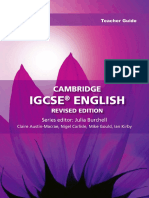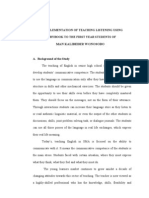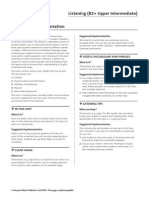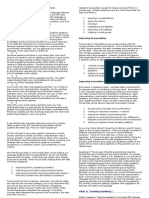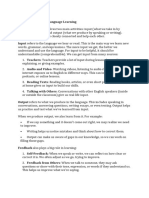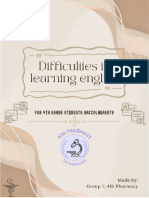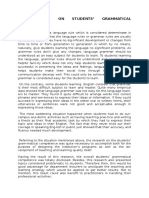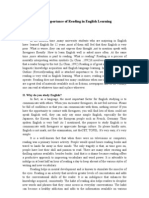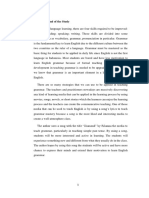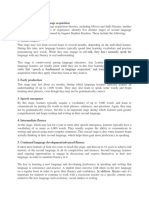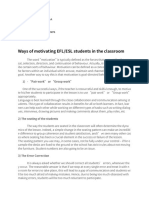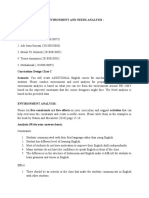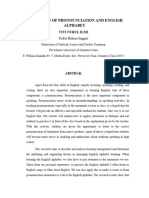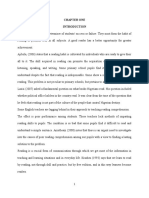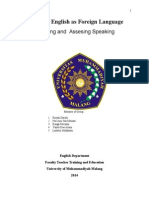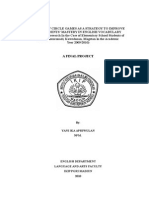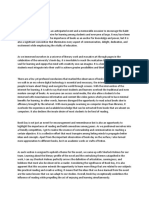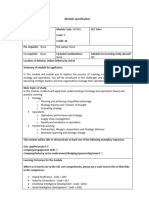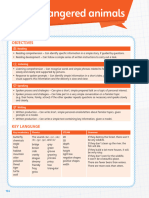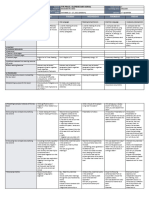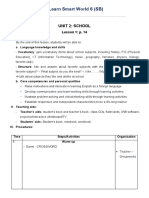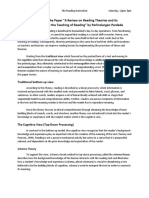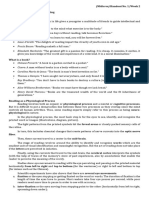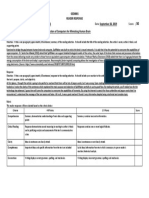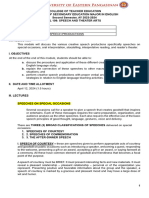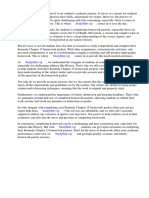Makalah Inggris
Makalah Inggris
Uploaded by
IwanHariyantoCopyright:
Available Formats
Makalah Inggris
Makalah Inggris
Uploaded by
IwanHariyantoOriginal Title
Copyright
Available Formats
Share this document
Did you find this document useful?
Is this content inappropriate?
Copyright:
Available Formats
Makalah Inggris
Makalah Inggris
Uploaded by
IwanHariyantoCopyright:
Available Formats
The Challenge of Teaching Listening and Conversation in English Class to Created Students Life Skills by Rina Puji Utami*)
Abstract Students need to apply the same approach to listening and conversation skills. The aim of English Life Skills is to enhance the participation of students with special education needs in all aspects of post-school life and promote their independence through the development of effective communication and literacy skills. Skills to be addressed through a plan include: listening to others in large and small groups, knowing how to take turns, contributing appropriately, sharing, being polite and respectful during all group and classroom activities. Skills in the yard include, sharing equipment and sports items (balls, skipping ropes, etc.), understanding the importance of teaming, avoiding arguing, accept team and sports rules, participating responsibly. Introduction Teaching listening skills is one of the most difficult tasks for any English teacher. This is because successful listening skills are acquired over time and with lots of practice. It's frustrating for students because there are no rules as in grammar teaching. Speaking and writing also have very specific exercises that can lead to improved skills. This is not to say that there are not ways of improving listening skills, however they are difficult to quantify. A good English conversation class involves more than sitting around chatting. To teach English conversation well, we will need to carefully plan and direct the class, yet make sure the conversation stays spontaneous and uninhibited. Learn how to teach English conversation so your students get free speaking practice and learn vocabulary and grammar, too. One of the largest inhibitors for students is often mental block. While listening, a student suddenly decides that he or she doesn't understand what is being said. At this point, many students just tune out or get caught up in an internal dialogue trying translate a specific word. Some students convince themselves that they are not able to understand spoken English well and create problems for themselves. They key to helping students improve their listening skills is to convince them that not understanding is OK. This is more of an attitude adjustment than
* )
The author is teacher at Budi Luhur Junior High School, Nganjuk and Lecturer at STIKIP Nganjuk, East Java
anything else, and it is easier for some students to accept than others. Another important point that the teachers try to teach their students (with differing amounts of success) is that they need to listen to English as often as possible, but for short periods of time. History of the English Language The history of the English language really started with the arrival of three Germanic tribes who invaded Britain during the 5th century AD. These tribes, the Angles, the Saxons and the Jutes, crossed the North Sea from what today is Denmark and Northern Germany. At that time the inhabitants of Britain spoke a Celtic language. But most of the Celtic speakers were pushed west and north by the invaders, mainly into what is now Wales, Scotland and Ireland. The Angles came from Englaland and their language was called Englisc, from which the words England and English are derived (www.englishclub.com). From the 16th century the British had contact with many peoples from around the world. This, and the Renaissance of Classical learning, meant that many new words and phrases entered the language. The invention of printing also meant that there was now a common language in print. Books became cheaper and more people learned to read. Printing also brought standardization to English. Spelling and grammar became fixed, and the dialect of London, where most publishing houses were, became the standard. In 1604 the first English dictionary was published. English Teaching For the most effective instruction toward English proficiency, English teachers need to focus on the core areas of English language instruction, including reading, writing, vocabulary, and grammar. Reading skills are necessary for English class students to interpret assignments, research projects, and perform well in non-English classes. Reading also practices vocabulary, exposes students to sentence structure, and can introduce concepts in nearly any content area. Strategies for teaching reading include: 1. Reading instructions aloud. This gives the teacher an opportunity to assist with pronunciation as well. 2. Book reports. Choosing books slightly below students grade level will help them master English skills while still keeping reading in the curriculum. 3. Free reading time. Allowing students to read English language books, magazines, and newspapers of their choice can help them practice reading skills with less pressure. 4. Deciphering vocabulary context clues. This can help students learn vocabulary while they read and will reinforce their reading skills. 5. Reading comprehension questions. Discussions of plot, characterization, and other aspects of books and short stories can help students refine their reading and speaking skills.
6. Dictionary use. Allowing students to use translation dictionaries to complete reading assignments will strengthen their English skills while teaching them how to use valuable reference resources (Ann Logsdon, 2009: 2). Writing a new language is far different than learning to speak it. English class students must be able to write effectively in English to perform well in both classes and future employment. Teachers who know how to teach an English class may use strategies and assignments such as: Autobiographies and country reports. Students writing about themselves and their native country can practice writing skills while introducing themselves to their peers. Journaling. Daily journal assignments can inspire writing practice on a variety of timely topics. Complete sentences. Requiring students to respond with complete sentences on any assignment will continually reinforce English writing skills. Wordless books. Teachers can use wordless childrens picture books to allow students to make up an appropriate story. Stories could then be read to younger siblings or classes for more practice. Essay questions. Incorporating essay questions into frequent assignments and tests keeps students writing skills in the forefront (Ann Logsdon, 2009: 3). Learning the vocabulary of a new language is essential for meaningful progress and mastery. Vocabulary strategies include: 1. Using cross-curricular terms. ESL teachers can ask students other teachers for appropriate words to incorporate into a vocabulary list. This has the added bonus of helping students study for other classes while they learn English. 2. Word of the day. Choosing a word of the day and discussing its definition is the perfect way to introduce unique vocabulary words to ESL students. 3. Flashcards. Quick practice can help students learn words efficiently. 4. Crossword puzzles. Another fun way to learn vocabulary, crossword puzzles can be an enjoyable assignment (Ann Logsdon, 2009: 3). For many English class students, learning grammar can be the most difficult part of adjusting to English. Teachers should pay particular attention to verb tenses, sentence structure and syntax, appropriate pronoun usage, and how to create plural words because these are often the most difficult areas of grammar for English class students. Teaching Listening In the teaching learning at English class, we like to use this analogy: Imagine you want to get in shape. You decide to begin jogging. The very first day you go out and jog seven miles. If you are lucky, you might even be able to jog the seven miles. However, chances are good that you will not soon go out jogging again. Fitness trainers have taught us that we must begin with little steps. Begin jogging short distances and walk some as well, over time you can build up the distance. Using this approach, you'll be much more likely to continue jogging and get fit (Kenneth Beare, 2009: 1)
Students need to apply the same approach to listening skills. Encourage them to get a film, or listen to an English radio station, but not to watch an entire film or listen for two hours. Students should often listen, but they should listen for short periods, five to ten minutes. This should happen four or five times a week. Even if they don't understand anything, five to ten minutes is a minor investment. However, for this strategy to work, students must not expect improved understanding too quickly. The brain is capable of amazing things if given time, students must have the patience to wait for results. If a student continues this exercise over two to three months their listening comprehension skills will greatly improve. How to Teach an English Conversation Class To teach English conversation well, it can do in several steps: 1. Step 1 Choose a topic and conversation format. You might just suggest a discussion topic or you could use a newspaper article, comics, an object or photos to set a theme for the conversation. Consider whether the topic is suited to an openended discussion or whether you could use a problem-solving or decisionmaking activity, information-gap exercise or role plays instead. 2. Step 2 Define your goals. Before you start to teach an English conversation class, decide what you want the students to learn from the conversation. You might want to teach phrases for expressing opinions or for disagreeing politely. You could also choose a grammar point or vocabulary set you'd like them to work on. 3. Step 3 Give the students a reason to listen to each other. No matter how much your students want to be in your English conversation class, it's human nature to tune out when it's not your turn to talk. To make sure your students pay attention to one another, give them a goal they can accomplish only by listening to the other students. For example, if your students are expressing their opinions on a certain topic, ask the them to decide which other student they most agree with. 4. Step 4 Build your students' knowledge. Instead of just correcting errors, add to what students say by suggesting new words and expressions. If someone uses a word in a way that's not quite right, you could ask the group, "What's another word that means...?" Keep your goals for the lesson in mind as you do this. 5. Step 5 Take notes. In the middle of a good discussion, students can get so involved in communicating that they hardly notice your attempts to add new vocabulary or fine-tune pronunciation. Make a note of anything you add so you can review at the end of the conversation class and in later classes, too. Also note errors you overhear so you don't need to interrupt the conversation to make corrections.
6.
Step 6 Provide a sense of completion and accomplishment. When you have 10 or 15 minutes left, wrap up the discussion and finish the English conversation class with focused language work. Write incorrect sentences you overheard on the board and ask students to correct them as a group. Go over the more useful vocabulary again. Doing this lets students see what they accomplished during the conversation (Miriam K, 2009).
Englishs Life Skills The World Health Organization promotes life skills school-based programs as a means to develop skills among young people that lead to healthy lifestyle choices and optimum physical, social, and psychological wellbeing. Depending on the culture, different specific abilities are emphasized. WHO considers the following life skills to be the most essential (WHO, 1993): 1. The ability to make decisions; helps students assess their options and carefully consider the different consequences that can result from their choices. 2. The ability to solve problems; helps students find constructive solutions to their problems. This skill can significantly reduce anxiety. 3. The capacity to think creatively; is essential to decision making and problem solving. It enables students to explore all possible alternatives together with their consequences. It helps students look beyond their personal experience. 4. The capacity to think critically helps students objectively analyze available information along with their own experiences. It is this ability that helps students recognize the factors that influence their behavior, such as societal values, peer influence, and influence of the mass media. 5. The ability to communicate effectively; helps students to express their feelings, needs, and ideas to others, verbally or otherwise. 6. The ability to establish and maintain interpersonal relations; helps students to interact positively with people whom they encounter daily, especially family members. 7. Knowledge of self; is the capacity of students to know who they are, what they want and do not want, and what does and does not please them. It also helps students recognize stressful situations. 8. The capacity to feel empathy; is the ability to imagine what life is like for another person in a very different situation. It helps students to understand and accept diversity, and it improves interpersonal relations between diverse individuals. 9. The ability to handle emotions; enables students to recognize their emotions and how they influence their behavior. It is especially important to learn how to handle difficult emotions such as violence and anger, which can negatively influence health. 10. The ability to handle tension and stress; is a simple recognition by students of the things in life causing them stress. The aim of English Life Skills is to enhance the participation of students with special education needs in all aspects of post-school life and promote their
independence through the development of effective communication and literacy skills. In English life skills students will: develop knowledge about and skills in effective communication; develop knowledge about, appreciation of and skills in spoken language; develop understanding and skills in listening to others; develop skills in reading, comprehending, interpreting and responding to a variety of texts; develop knowledge about and skills in producing texts using a variety of media and technology; develop knowledge about and skills in viewing and interpreting a range of materials (New South Wales Public School, 2009: 3). The focus for personal responsibility or accountability is ensure a plan is in place for students to: complete learning tasks on time, to hand in assigned work and to use the home/school agenda or tracking system in place. In the classroom, a plan is needed to ensure the student: follows directions, raises his/her hand before speaking, remains on task without wandering, work independently and cooperate by following the rules. Skills to be addressed through a plan include: listening to others in large and small groups, knowing how to take turns, contributing appropriately, sharing, being polite and respectful during all group and classroom activities. Skills in the yard include, sharing equipment and sports items (balls, skipping ropes, etc.), understanding the importance of teaming, avoiding arguing, accept team and sports rules, participating responsibly. Summary Life skills includes the skills the student needs to be successful in society. Students with life skills programs are often those with severe learning disabilities, autistic tendencies, developmental disorders, etc. For the most part, you can't take day to day responsibility for granted with these students. They need strategies in place to help them learn the essential life skills. They need to learn to be responsible for care of property, understanding the basic social rules, how to behave under different circumstances. The details I've listed will help you set up tracking systems or work with the student to enhance those necessary skills. Once the student has some understanding, you'll want self-tracking or monitoring to occur. You may want to devise a tracking sheet for specific areas to keep the student focused and on target. There is more to teaching an English class than giving appropriate assignments and assessing students abilities. Effective teachers will: 1. Create a supportive environment with a classroom that honors students cultures. 2. Be a role model for effective reading and writing.
3. Minimize translation assistance to encourage students to learn English more effectively. 4. Make classroom activities relevant to students lives and other classes. 5. Use abundant visual aids to reinforce written and spoken words. 6. Adjust the pacing of their instruction to meet students needs and proficiency. 7. Encourage peer tutoring to allow students to interact and share tips with one another. 8. If a particular student seems unwilling to join in the conversation, find out why. They may be confused about what they're supposed to say, lack vocabulary or just not have an opinion on the topic. Once you understand why they're not talking, you'll be better able to draw them into the discussion. 9. Many otherwise confident people are intimidated by having to speak a foreign language. To help students become less inhibited, take care not to call a lot of attention to one any individual's errors and try to keep a casual atmosphere. English teachers generally need specialized licenses or certificate endorsements to teach English language learners, but knowing how to teach an English class involves more than just a special license. Understanding appropriate strategies and how to apply them to students will help teachers be more effective so their students can become confidently bilingual.
References: Ann Logsdon. 2009. How to Teach an ESL Class. www.discoverbetterhearing.com., accesed in November 2009. Kenneth Beare. 2009. The Challenge of Teaching Listening Skills. www.about.com., accesed in November 2009. Miriam K. 2009. How to Teach An English Conversation Class . Article. www.ehow.com., accessed in November 2009. New South Wales Public School. 2009. Learning and Teaching. New South Wales: NSW Public School Editorial. WHO. 1993. Life skills. New York: World Health Organization Study Department. www.englishclub.com. A Short History of The Origins and Development of English, accesed in November 2009.
You might also like
- 2 IGCSE English Teacher's GuideDocument9 pages2 IGCSE English Teacher's Guidekitty christina winston67% (6)
- Tugas 1 Esp Musdalifah Bc73 1847242028Document7 pagesTugas 1 Esp Musdalifah Bc73 1847242028musdalifah 940No ratings yet
- TKT Unit 3Document41 pagesTKT Unit 3Jelena MitrovicNo ratings yet
- An Innovative Approach To Teaching English Listening and Speaking Skills As A Foreign Language in A Language Lab ClassroomDocument5 pagesAn Innovative Approach To Teaching English Listening and Speaking Skills As A Foreign Language in A Language Lab ClassroomNor HazimahNo ratings yet
- Proposal Skripsi FKIP InggrisDocument18 pagesProposal Skripsi FKIP Inggrisbudijvc86% (14)
- MAKALAH EYL KEL. 7 fiksDocument12 pagesMAKALAH EYL KEL. 7 fiksFajrina Zulfa DarumiarsiNo ratings yet
- Listening B2 All DocumentsDocument14 pagesListening B2 All DocumentsvadlienNo ratings yet
- Sample For Esp Final Assignment-Course DesignDocument10 pagesSample For Esp Final Assignment-Course Designmailinh280896No ratings yet
- Elt NotesDocument18 pagesElt NotesafrawrrNo ratings yet
- Video DebateDocument5 pagesVideo Debateapi-570988433No ratings yet
- Types of PatternDocument25 pagesTypes of Patternmaylene marquezNo ratings yet
- How To Teach Speaking Activities To ESL StudentsDocument3 pagesHow To Teach Speaking Activities To ESL StudentsThias Arisiana100% (2)
- Chapter 8: Difficulties in Teaching English Language and The Different ApproachesDocument11 pagesChapter 8: Difficulties in Teaching English Language and The Different ApproachesJoshua SantosNo ratings yet
- MetoDocument12 pagesMetoRana QuliyevaNo ratings yet
- Chapter One: 1 Rudheford, Grammar in The Second Language Classroom, (New York. London: Prentice Hall, 1987) - P.9Document7 pagesChapter One: 1 Rudheford, Grammar in The Second Language Classroom, (New York. London: Prentice Hall, 1987) - P.9MalurRahmiNo ratings yet
- Quot English Quot Ingilis Dili Asas Xarici Dil Fanni Uzra 5 Ci Sinif Ucun Metodik VasaitDocument164 pagesQuot English Quot Ingilis Dili Asas Xarici Dil Fanni Uzra 5 Ci Sinif Ucun Metodik Vasaiteliyevasona06No ratings yet
- Phase 3.1 Teaching Techniques (Language Skills)Document60 pagesPhase 3.1 Teaching Techniques (Language Skills)Madhuri KarnewarNo ratings yet
- Literature Review: 2.2.1 Definition of Speaking SkillDocument9 pagesLiterature Review: 2.2.1 Definition of Speaking SkillUswatun HasanahNo ratings yet
- A Pragmatic Approach For Learning English LanguageDocument4 pagesA Pragmatic Approach For Learning English LanguageAlexander DeckerNo ratings yet
- 3,4Document3 pages3,4Quỳnh DoãnNo ratings yet
- Dyna Ariyani-Improving Students' Pronunciation by Using Reading Aloud in Junior High SchoolDocument9 pagesDyna Ariyani-Improving Students' Pronunciation by Using Reading Aloud in Junior High SchoolNurmeida UrwaniNo ratings yet
- Effective Teaching Using Modern TechnologiesDocument5 pagesEffective Teaching Using Modern TechnologiesАйжанNo ratings yet
- Seminar ProposalDocument51 pagesSeminar ProposalDonda SeftianiNo ratings yet
- Tugas 2 Esp Musdaliah Bc73Document2 pagesTugas 2 Esp Musdaliah Bc73musdalifah 940No ratings yet
- Identification of Difficulties Teydhn FinDocument12 pagesIdentification of Difficulties Teydhn Finsophiaalmonte63No ratings yet
- How To' Guide To Teaching English My WayDocument18 pagesHow To' Guide To Teaching English My WayShaher AlburaihyNo ratings yet
- The Problem and Its BackgroundDocument9 pagesThe Problem and Its BackgroundWalfrido SantosNo ratings yet
- Research Proposal Research Title: The Impact of Novel On Improving Students' English Vocabulary: A QuasiDocument8 pagesResearch Proposal Research Title: The Impact of Novel On Improving Students' English Vocabulary: A QuasiAnonymous MULUgfwn4ONo ratings yet
- Teaching ListeningDocument15 pagesTeaching ListeningJennifer VanceNo ratings yet
- This Approach Allows Teachers To Track Students Progress in Multiple SkillsDocument4 pagesThis Approach Allows Teachers To Track Students Progress in Multiple SkillsMishil CarillasNo ratings yet
- The Language Skills 1 TEFL AIOUDocument24 pagesThe Language Skills 1 TEFL AIOUPrince Kazmi100% (1)
- An Analysis On StudentsDocument6 pagesAn Analysis On StudentsMuhamad Anandia PradiatamaNo ratings yet
- Increasing Students' Speaking Skill by Using Pictures As Instructional MediaDocument50 pagesIncreasing Students' Speaking Skill by Using Pictures As Instructional Mediadeenaismeeh83% (6)
- Chapter 6Document11 pagesChapter 6mulyadiNo ratings yet
- The Language Skills-I 5659Document25 pagesThe Language Skills-I 5659mubarak201160% (5)
- Grade 8 English TG FinalDocument178 pagesGrade 8 English TG Finalteshometegene04No ratings yet
- Free Tefl2Document18 pagesFree Tefl2AmerNo ratings yet
- Proposal Bab 2 & 3Document29 pagesProposal Bab 2 & 3Nurhaliza NasutionNo ratings yet
- The Importance of Reading in English LearningDocument7 pagesThe Importance of Reading in English LearningMohammed AbuhaibNo ratings yet
- General Approach To Teaching English - 16Document16 pagesGeneral Approach To Teaching English - 16hectorNo ratings yet
- Error Correction 2Document24 pagesError Correction 2BAGASKARANo ratings yet
- Listening and Speaking Teaching Materials and On-Line ResourcesDocument42 pagesListening and Speaking Teaching Materials and On-Line Resourcesnicelucky1No ratings yet
- Seminar ProposalDocument13 pagesSeminar ProposalDanti ArdianiNo ratings yet
- Method in TeachingDocument16 pagesMethod in TeachingYoucef GherbiNo ratings yet
- Five Stages of Second Language AcquisitionDocument4 pagesFive Stages of Second Language Acquisitionaros.mohammed22No ratings yet
- Summary AyuDocument5 pagesSummary Ayupiston63freeNo ratings yet
- Group 4 Curriculum Design Class C 2020Document4 pagesGroup 4 Curriculum Design Class C 2020Shulis AzzahraNo ratings yet
- English Language TeachingDocument4 pagesEnglish Language TeachingMarryiam KhanNo ratings yet
- Defenition of Pronounciation and English AlphabetDocument6 pagesDefenition of Pronounciation and English AlphabetVivi Nurul IlmiNo ratings yet
- C Design 2Document18 pagesC Design 2Bechir SaoudiNo ratings yet
- Report On English Programme 1Document16 pagesReport On English Programme 1Jay SuriaraoNo ratings yet
- English Teaching CriteriaDocument2 pagesEnglish Teaching CriteriaMaria de JesusNo ratings yet
- Bab 1Document31 pagesBab 1Matsna SyarifNo ratings yet
- A. Background of The StudyDocument9 pagesA. Background of The StudyMuhammad YasinNo ratings yet
- General ObjectivesDocument15 pagesGeneral ObjectivesMRMohanadNo ratings yet
- MalikDocument37 pagesMalikMohammed Abu ShaibuNo ratings yet
- Libro 3,4,5 CompletoDocument82 pagesLibro 3,4,5 CompletoGonzalo GuarnizoNo ratings yet
- Tefl MakalahDocument8 pagesTefl MakalahInggrit SisiliaNo ratings yet
- Tefl - Module OneDocument24 pagesTefl - Module OneFithrah NurulNo ratings yet
- Why Do English Second Language Students Have Speaking Problems?From EverandWhy Do English Second Language Students Have Speaking Problems?No ratings yet
- Chapter IDocument11 pagesChapter IIwanHariyantoNo ratings yet
- Definition of The Noun Afterlife: Avenged SevenfoldDocument4 pagesDefinition of The Noun Afterlife: Avenged SevenfoldIwanHariyantoNo ratings yet
- A Final Project: By: Yani Ika Apriwulan NPMDocument28 pagesA Final Project: By: Yani Ika Apriwulan NPMIwanHariyantoNo ratings yet
- The Legend of SurabayaDocument2 pagesThe Legend of SurabayaIwanHariyantoNo ratings yet
- AGKBiblical Law DiscourseDocument138 pagesAGKBiblical Law DiscoursetetetyankaNo ratings yet
- The Legend of SedudoDocument2 pagesThe Legend of SedudoIwanHariyantoNo ratings yet
- Junior Accounting Staff - KALTIMEX ENERGY, PTDocument4 pagesJunior Accounting Staff - KALTIMEX ENERGY, PTIwanHariyantoNo ratings yet
- Discourse Analysis 3aDocument19 pagesDiscourse Analysis 3aIwanHariyantoNo ratings yet
- Field Study IDocument7 pagesField Study IMaya BabaoNo ratings yet
- Summer Holiday Homework 6Document23 pagesSummer Holiday Homework 6Archi VarshneyNo ratings yet
- Book Day ReDocument1 pageBook Day ReDan Ezekiel GustiloNo ratings yet
- Activity 3Document5 pagesActivity 3genesis mojicaNo ratings yet
- Tabogoc PipDocument10 pagesTabogoc PipPowell Tabogoc100% (1)
- Grade 5 Language 2-6 SeptemberDocument3 pagesGrade 5 Language 2-6 Septemberfarahishtiaq721No ratings yet
- UEL-SG-7001 - Module SpecificationDocument4 pagesUEL-SG-7001 - Module SpecificationNea Mills100% (1)
- Full Download Democracy and Education by John Dewey: With A Critical Introduction by Patricia H. Hinchey 1st Edition John Dewey PDFDocument69 pagesFull Download Democracy and Education by John Dewey: With A Critical Introduction by Patricia H. Hinchey 1st Edition John Dewey PDFnujeamameish100% (1)
- EC4 AmE U5 TBDocument20 pagesEC4 AmE U5 TBpaulina herreraNo ratings yet
- DLL - English 5 - Q1 - W9Document7 pagesDLL - English 5 - Q1 - W9Richard CruzNo ratings yet
- The Diagnostic Assessment Tools in English Literature ReviewDocument7 pagesThe Diagnostic Assessment Tools in English Literature Reviewedw68No ratings yet
- Young Warriors Lesson PlansDocument15 pagesYoung Warriors Lesson Plansbloodtommy70100% (1)
- Tiếng Anh 6 Smart World - Unit 2 - SCHOOL - SBDocument26 pagesTiếng Anh 6 Smart World - Unit 2 - SCHOOL - SBponyoNo ratings yet
- JSS 1 English Lesson Note For Third TermDocument38 pagesJSS 1 English Lesson Note For Third Termojo ayodeji johnsonNo ratings yet
- AEF1 Files7-12 ProgTestA&B AnswerKeyDocument4 pagesAEF1 Files7-12 ProgTestA&B AnswerKeyБодь ТөвNo ratings yet
- Class-KG-week4-week 4 APSACS Online Support Program Week4Document23 pagesClass-KG-week4-week 4 APSACS Online Support Program Week4Zeeshan JafarNo ratings yet
- Course Description:: Practical English Reading and Writing Fall 2019Document2 pagesCourse Description:: Practical English Reading and Writing Fall 2019Anonymous 3gZ8Q5GMNo ratings yet
- Action Plan On Reading Intervention For Struggling Readers - For Education Dept.Document3 pagesAction Plan On Reading Intervention For Struggling Readers - For Education Dept.Berlyn ColegadoNo ratings yet
- (Individually) Task 2 - Task 2 - Principles of Materials Designing. - Grupo 2 - Ely Bertel.Document15 pages(Individually) Task 2 - Task 2 - Principles of Materials Designing. - Grupo 2 - Ely Bertel.maria lozanoNo ratings yet
- Summary On "A Review On Reading Theories and Its Implication To The Teaching of Reading" by Parlindungan PardedeDocument5 pagesSummary On "A Review On Reading Theories and Its Implication To The Teaching of Reading" by Parlindungan PardedeKayle BorromeoNo ratings yet
- HO1. Week 2Document3 pagesHO1. Week 2Cgc Bryan Del PilarNo ratings yet
- 78707-Article Text-184533-1-10-20230426Document6 pages78707-Article Text-184533-1-10-20230426Thu Trang VũNo ratings yet
- Reader Response 9.26.2019Document1 pageReader Response 9.26.2019Angelo PayodNo ratings yet
- Reflection of The YearDocument7 pagesReflection of The Yearapi-709991599No ratings yet
- EL 109 Module 5 FinalsDocument7 pagesEL 109 Module 5 FinalsKatkatNo ratings yet
- Uet COMMUNICATION SKILLS - Outline-1Document5 pagesUet COMMUNICATION SKILLS - Outline-1Muhammad HamzaNo ratings yet
- Kennedy Chapter 15 Homework Packet AnswersDocument7 pagesKennedy Chapter 15 Homework Packet Answerscfb5xv2v100% (1)
- PASSAGEDocument11 pagesPASSAGEds4458001No ratings yet
- Unit 8 Lesson 3.1 10D1Document5 pagesUnit 8 Lesson 3.1 10D1Minh QuangNo ratings yet

